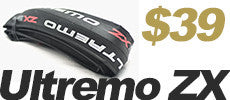There has been much talk about the newest tubeless tyres from Schwalbe and Hutchinson. To avoid any confusion: Tubeless tyres are not the same as traditional tubular tires.
The classic tubular tyre has a built-in tube and requires specific rims, where the tyre can be glued on. A tubeless tyre looks much the same as a standard clincher tire, but does not require a separate tube at all. Instead, it uses a liquid sealant and a specific design to keep the pressure. The tubeless system also requires specific rims, which do not have the typical holes for the spoke nipples in the rim bed. But unlike the tubular rims, the tubeless rims can be used with standard clincher tires as well. If unsure, just check if your wheels allow the use of tubeless tires. A small sticker on your wheelset should usually indicate if suitable.
Further, if your rim beds do not require rim tape (no holes on inside), this could be an indicator that your wheels are suitable for tubeless tyres. But why should one use tubeless tyres and not stick to tubulars or standard clinchers? The answer to this is simple: You can continue using whatever you prefer – but: So far, tubeless tires have the advantage of increased puncture resistance through the tire sealant, which can instantly seal holes up to 1.5mm wide, stopping immediate deflation (see photo). A nail or safety pin stuck in your regular clincher or tubular tire would usually deflate the tyre immediately. But the tubeless tyre will likely hold a certain pressure, allowing you to stop on a fast downhill or to even finish the ride with just less pressure in your tyre.
Until today, the disadvantages of the tubeless system (rolling resistance, grip and difficult assembling) have outweighed this advantage for most of us. Further, many riders still believe that tubular tires offer the least rolling resistance over any other system. This has been proven to no longer apply in several tests, when tubulars are compared with the best clincher tyres. The best clincher tires have better rolling- & puncture resistance than the top-tubulars (First relevant comparison released in TOUR 9/2007).  Why are many Pros still using tubular tires then? Believe it or not, a lot of this has simply to do with the long tradition tubulars have in the peloton and further a lack of interest in the technical developments from their teams. Arguably, a tubular tire offers different handling when cornering (mainly because it keeps a round profile when under pressure vs. a clincher becomes slightly oval). In addition, a tubular is less affected by "snakebite" punctures, especially on cobblestones.
Why are many Pros still using tubular tires then? Believe it or not, a lot of this has simply to do with the long tradition tubulars have in the peloton and further a lack of interest in the technical developments from their teams. Arguably, a tubular tire offers different handling when cornering (mainly because it keeps a round profile when under pressure vs. a clincher becomes slightly oval). In addition, a tubular is less affected by "snakebite" punctures, especially on cobblestones.
But for example, Time Trial World Champion Tony Martin has deliberately chosen to ride clincher tires after he got aware of the findings revealed after extensive testings conducted by the TOUR magazine. Unfortunately TOUR only publishes their great tests in German language, which makes it very difficult for the greater cycling community to read the most advanced tests in the bike industry. Most recently, their engineers have once again reviewed and tested a bunch of clincher and tubeless tyres to investigate if tubeless tyres are able to take on clinchers yet. The review includes data gained from the laboratory as well as road testing. How exactly does TOUR test the tyres?
In this particular article, the review was about puncture resistance (Pannenschutz) vs. rolling resistance (Rollwiderstand). The engineers used a special setup (see photo) where the tyres can run at different angles on various surfaces, similar to the changing quality of any tarmac and riding style. In the two diagrams you can see the time (s/Time) it took a spike to puncture the tyre (Stechzeit) and how much pressure (N/Force) was applied (Durchstichkraft) before it finally punctured. In the second diagram, the rolling resistance (W/Watts) is listed. All tyres had the same pressure (7.5 Bar/108.77 Psi) and were tested on different surfaces/angles. Possible tolerances are shown as blue lines at the end of each bar. 
January 28, 2013





